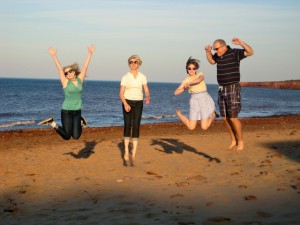In their article on Andy Rooney’s passing, CNN.com describes him as someone who “chronicles the particular.”
This phrase especially resonated with me after Dean Shareski shared his vision of story in workshops at our high school last Thursday, as well as in his keynote at Tech Forum Austin.
His eye for story in the most amusing details is clear in the video he opened his presentation for our teachers with.
The backstory–his wife was on the decorating committee for his daughter’s graduation party and as part of that was charged with creating paper flowers. So he chose to use video to convey the story in a very particular (and amusing way). Watching this with a group of our teachers, as the surprising visuals unfold and hearing the ensuing laughter, convinced me that when we chronicle the ordinary absurdities of our lives, there is a story there.
Dean’s Prezi presentation for his session on Story illustrates the power of good stories and illuminated some new forms for telling them that go beyond the ordinary–through creative editing, creative use of text only(kinetic typography), with remixing, with many words, and with few words(one word and six word stories). Sites like ZeFrank’s very cool “young me/menow” or his “earth sandwich” project are other creative ways to tell story in new ways. (btw, Brian Doyle has a nice summary post of the activities that Dean shared at our campus.)
But one thing that was especially enlightening in spending time in these workshops was in seeing how Dean has developed his own unique voice through photography and video, and it reminded me how we need to help students find their unique voice visually as well. As he mentioned at Tech Forum, his project of taking one photograph per day has been one helpful tool in developing mindfulness about images and the world. Of course, there are a number of photo-per-day projects, but imagine the value of challenging your students to participate in them?
Another project he shared that must be very impactful for students–he is having his university students spend x number of weeks learning something new and chronicling their learning through video and what it teaches them about their own learning. Having them tell their learning story as they do the project is an excellent way to help them see the power in becoming “chroniclers of the particular” as well. What if we asked students to document their research for a paper on video and post it? How would that help both their self-reflection and our understanding of their processes and needs?
Dean reminded the audience at Tech Forum of Gary Stager’s comment that ‘youth are intense.’ As he pointed out, we just need to illuminate the things that they are intense about and help them share them, because as he repeats from Jill Taylor’s TED Talk–‘To feel and to be felt is what’s important.’
 And telling stories, of course, is very importantly about the emotions they resonate with. Learning can be a joyous feeling, and so Dean gave the audience at Tech Forum a much needed reminder that we need to find opportunities to bring joy into what we do in education.
And telling stories, of course, is very importantly about the emotions they resonate with. Learning can be a joyous feeling, and so Dean gave the audience at Tech Forum a much needed reminder that we need to find opportunities to bring joy into what we do in education.
He visualized that by sharing these wonderfully playful photographs that his family creates of themselves jumping into the air in various vacation spots. What a joyful approach to a family photograph and what more memory that will create (like the backstory of how each photo was created).
We all have special gifts, and like Andy Rooney’s, Dean Shareski’s is in the power of noticing and appreciating all the ways stories can be told, and in seeing the world in mindful ways. Our students (and teachers) can all find ways to tell those stories of the particular in interesting and unique ways because all of us have a unique voice.
As we walked on a tour of Austin or toured small town BBQ Texas with colleagues yesterday, I felt like I was seeing with new eyes–the eyes of a storyteller. I’ve always seen things as a photographer, but of one moment in time, that wasn’t necessarily connected by story. Yesterday I saw everything in terms of how I could tell it as a story and how much more that would add to the experience, both in my observation of it at the moment, but also beyond that moment, in sharing it with others. It is all in what we bring our attention to, as I learned when designing our library.
So, expect more stories from me soon. Thanks, Dean, for the insights and for your time with our teachers.
Postscript: Dean Shareski’s prezi is below